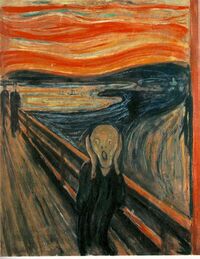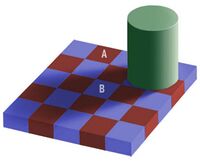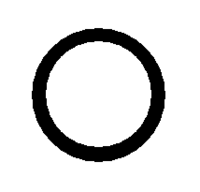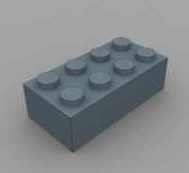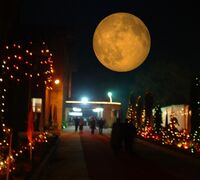Optical illusion
“Illusion is the first of all pleasures.”
Optical illusions are created when the Illumanati hack into your brain, and make you hallucinate. They make you go ๏_๏. It is a clever tactic, which no one has noticed, except me. The problem is, no one knows who these Illumanati members are because the Illumanatti does not exist and is in fact made up in yout mind, the real illusion.
The Internet was once thought to be a great source for optical illusions, until it turned out that it was a clever illusion in itself; the internet only has two optical illusions, and neither are true optical illusions at all. The first is a picture of a woman so fat you can't see anything else in that picture, the background being entirely obscured by her fat. The second is simply a scary picture which users are invited to concentrate on, becoming more and more terrified, until it suddenly changes to a picture of fluffy bunnies, surprising the user to death.
The origin of optical illusions[edit]
Optical illusions were invented in 1890 by Oscar Wilde, with the seminal "The Picture of Dorian Gray". On first viewing, the picture is full of colour and contrast. However, upon closer inspection, it has no colour or shade at all; it was painted, as the title suggests, using only one colour of paint - "Dorian Gray".
Critics marveled at Wilde's genius, and the optical illusion fad quickly caught on, with several others appearing soon after, including -
- Charles Dickens' "A Tale of Two Cities", a book in which there appears to be two cities; by the end it turns out that there was in fact one city, as the reader has been asleep throughout the majority of the book.
- Queen Victoria, who, to those not looking closely enough, appeared to be a member of Queen; she was in fact just a train station. This illusion was so successful, she was once voted Queen of England, and to this day, most people do not see through the illusion.
Types of optical illusion[edit]
There are several different types of optical illusion (or are there?), categorised as follows:
Same color illusions[edit]
These illusions are where the colors in the picture are not what they seem to be at first. In the example on the right, though the squares appear to be different, square A is exactly the same color as square B.
Other color illusions -
- A popular example of this type of illusion is Michael Jackson. To most people he appears to be a steady gradient going from black to white, when he is in fact entirely bleen.
- The American democratic and republican parties' colours appear to be blue and red respectively, but are actually both the same colour, and indeed, the same party.
Distortion illusions[edit]
Distortion illusions are where the dimensions of an object seem to change, or appear to be impossible.
An example of this is shown on the right. The square in that picture, when looked at from any angle greater than 0, will appear to be circular in nature. Try to see that it is not any square that looks like a circle, but a triangle shaped one.
Motion illusions[edit]
Motion illusions are where objects which at first appear stationary appear to be in motion on closer "inspection", or vice-versa, or objects which seem to be rotating counterclockwise eventually start moving in a straight line, or objects which appear to be moving upwards, eventually ... well, move upwards.
Real life distortion illusions[edit]
- Rubik's cubes - only 6 of its 12 sides can be perceived at any one time.
- The Niagra Falls - due to the mist created by the falls, they always appear bigger than they are. They are in fact only three feet high.
- Midgets - who are not actually small; they're just normal people seen from far away.
- The pyramids - The sun's light reflecting off the desert makes these look the opposite way up than they actually are. The points actually go down.
- Tornadocane - Actually trillions of nanobots, with destructive programing errors. They tend to take the shape of houses and cows.
Hidden image illusions[edit]
Hidden Image Illusions are illusions where an image is hidden amongst other images (examples of this include "Where's Oscar?"), or when an image is invisible to the human eye unless looked at for a long period of time (see the example to the right).
Other illusions[edit]
- This article - When tilted towards light, this page may appear to be about optical illusions. It is actually blank.
- Objects in the wing mirrors of your car are much smaller than they seem.
- The sky
- Freedom
- Sanity
- The belief that you're doing something useful with your life by reading Uncyclopedia.
Non-illusions[edit]

The following is a list of things that are believed to be optical illusions, but are actually real.
- The Moon - i.e. the so called "moon illusion" where the full moon appears bigger on the horizon.
- Spanners
- Hudson Leick (yes, she really is that sexy!)
- The ugly one from Buffy The Slayer of Vampyres
- George W Bush
- The bright spots you see when you poke your eye
- Wikipedia
- Snails
- Spider transporter pads
- Disappearing Elephants
Controversy[edit]
In 2005, the Kansas school board ruled that all schools had to started teaching the "An optical illusion is something which visually appears to be something other than what it is" theory alongside the more widely accepted "All optical illusions are exactly what they appear to be" theory, claiming that the latter was "just a theory", and they wanted people "to see both sides of the optical illusion argument".
This followed calls by many to put stickers next to all optical illusions, with disclaimers stating - "this is an optical illusion, and may not be what it appears to be". This outraged many parents, who promptly invited the Government to send the National Guard into their towns to prove once and for all the truth about optical illusions.
Several townspeople were shot attempting to put the stickers on the army, claiming that it was optical illusion itself.

